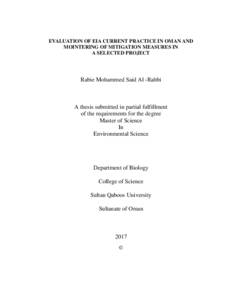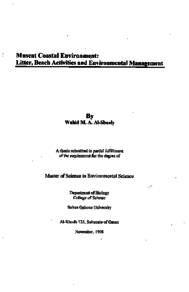Document
Evaluation of EIA current practice in Oman and mointering of mitigation measures in a selected project
Publisher
Sultan Qaboos University
Gregorian
2017
Language
English
Subject
English abstract
Sultanate of Oman was one of the first MENA countries to enact Environmental Impact Assessment (EIA) legislations in 1982 by the Royal Decree (RD) 10/82 through "Law on the conservation of the environment and prevention of pollution". The main objective of this research is to evaluate the current EIA practice in Oman by assessing 1. The quality of the EIA reports from four major sectors with an established comprehensive review criteria.2.The perspective of two main EIA stakeholders namely the regulator and the developer through questionnaire survey. An additional objective was attempted to assess the efficiency of mitigation measures in a cement plant as a case study. The study found that the quality of 60 percent of EIA reports fall in the 'unsatisfactory' category. In-depth review of categories, subcategories, reveals that the key areas of EIA reports lack proper attention. The inadequacies are in areas related to identification and evaluation of impacts, mitigation of key impacts and consideration of alternatives. The survey results also found the EIA practice in the country has several weakness identified by both the regulator and developer. In general, factors influencing the quality of EIA system are highlighted. The case study in the cement plant clearly reveals the mitigation measures help in reducing the PM emission from 392 mg/m3 in 2009 to 43.8 mg/m3 in 2016.The study put forth a set of recommendations for the improvement of EIA process in the Sultanate of Oman.
Description
Thesis
Member of
Resource URL
Arabic abstract
كانت سلطنة عمان من أوائل دول منطقة الشرق الأوسط وشمال أفريقيا التي سنت تشريعات تقييم82 من خلال قانون حماية البيئة / الأثر البيئي في عام 1982 بموجب المرسوم السلطاني رقم 10 ومكافحة التلوث".الهدف الرئيسي من هذا البحث هو تقييم الممارسة الحالية لتقييم الأثر البيئي في عمان من خلال تقييم 1. جودة تقارير تقييم الأثر البيئي من أربعة قطاعات رئيسية بإستخدام معايير المراجعة الشاملة المعمول بها 2. وجهة نظر اثنين من أصحاب المصلحة الرئيسيين في تقييم الأثر البيئي وهما الجهة التنظيمية و المطور من خلال إجراء استبيان.وقد تم محاولة تحقيق هدف إضافي لتقييم كفاءة تدابير التخفيف في مصنع الأسمنت كدراسة حالة. وجدت الدراسة أن جودة 60 % من تقارير تقييم الأثر البيئي تندرج ضمن فئة "غير مرضية". وباستعراض متعمق للفئات والفئات الفرعية، يكشف أن المجالات الرئيسية لتقارير تقييم الأثر البيئي تفتقر إلى الاهتمام المناسب. حيث تكمن أوجه القصور في المجالات المتصلة بتحديد وتقييم الآثار، والتخفيف من الآثار الرئيسية، والنظر في البدائل. كما وجدت نتائج المسح أيضا أن ممارسة تقييم الأثر البيئي في البلاد لديها العديد من الضعف التي حددها كل من المنظم والمطور. كما تم بصفة عامة، تسليط الضوء على العوامل التي تؤثر على جودة نظام تقييم الأثر البيئي. وتبين دراسة الحالة في مصنع الأسمنت بوضوح أن تدابير التخفيف تساعد في خفض انبعاثات الجزيئات العالقة من 392 ملغم / م 3 في عام 2009 إلى 43.8 ملغم / م 3 في عام 2016 وقدمت الدراسة مجموعة من التوصيات لتحسين عملية تقييم الأثر البيئي في سلطنة عمان
Category
Theses and Dissertations


